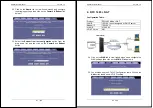
X8824r User’s Manual Version 1.0
53 / 102
When a packet matches a rule, it can either be accepted
(forwarded towards its destination), or denied (discarded),
depending on the action specified in the rule.
Bridge Filter
: Click on the
Enable
or
Disable
radio button
to activate/deactivate the service. Although each rule is
independently enabled and disabled, no rules will be
effective unless the Enable radio button is selected here.
Default Action:
Select
Accept
or
Deny
from the
drop-donw list. By accepting or denying this action will
affect all packets on all interfaces.
Click on the
Submit
button when completed and make sure
to
Commit & Reboot
.
Click on the
Add
button to add a bridge filter rule.
Rule ID:
Each rule must be assigned an ID number. Rules
are processed from lowest to highest on each data packet,
until a match is found. Rule numbers up to 99 are reserved
for preconfigured system rules.
Rule IDs must start at
1000 or above so that they do not interfere with
system-defined rules.
It is also recommended that you
X8824r User’s Manual Version 1.0
54 / 102
assign rule IDs in multiples of 5 or 10 (e.g., 1000, 1010,
1020) so that you leave enough room between them for
inserting new rules if necessary.
Interface
:
Enter the interface name on which the rule will
take effect.
Direction
:
Specifies whether the rule should apply to
packets that are incoming or outgoing on the selected
interface.
Incoming
refers to packets coming in to the LAN
on the interface, and
Outgoing
refers to packets going out
from the LAN. You can use rules that specify the incoming
direction to restrict external computers from accessing your
LAN.
In Interface
: The interface from which packets must
be forwarded in order for this rule to be invoked. For
example, if the Interface criteria is set to
ppp-0
, then the In
Interface could be set to
usb-0
. This specifies that the rule
applies only to packets passed from the USB computer
through the router's PPP interface. This option is valid only
for rules defined for the outgoing direction.
Action
: Specifies what the rule will do to a packet when the
packet matches the rule criteria. The action can be
Accept
(forward to destination) or
Deny
(discard the packet). Do
not select the CallMgt option.
Log Option
: When
Enabled
is selected, a log entry will be
created on the system each time this rule is invoked.
Logging may be helpful when troubleshooting. You can
also
disable
logging, log only packets that match rules, or
log only packets that do not match rules.
Click on the
Submit
button when completed and make sure
to
Commit & Reboot
.
9.6 Domain Name Service (DNS)
Click on the
DNS
link to view the DNS Configuration table. This
page is used for adding and deleting DNS server IP addresses.
Domain Name System (DNS) servers map the user-friendly
domain names that users type into their Web browsers (e.g.,
"yahoo.com") to the equivalent numerical IP addresses that are
used for Internet routing.






























